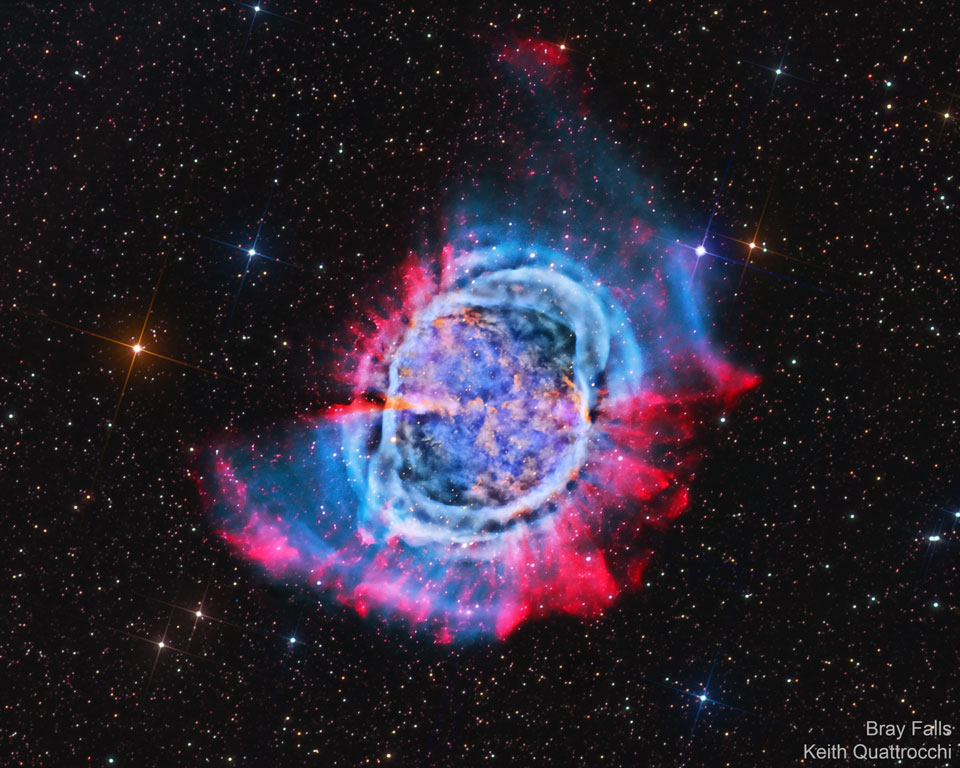12. July 2021
M27:啞鐘星雲

探索宇宙1!逐工會揀一幅無仝款 ê 影像抑是相片,𤆬你熟似咱這个迷人 ê 宇宙,閣有專業天文學者2為你3解說4。
- 原始文章:M27: The Dumbbell Nebula
- 影像來源 kah 版權:Bray Falls & Keith Quattrocchi
- 台文翻譯:An-Li Tsai (NCU)
[漢羅] M27:啞鐘星雲
咱 ê 太陽 紲落來會變做啥物? 咱太陽 ê 未來,頭一个暗示 tī 1764 年 to̍h 有人無意中揣著矣。 彼陣,Charles Messier 當咧編一个星表。 內底是一寡 boăi kah 彗星相濫 ê 擴散天體。 Messier 星表 內底第 27 个天體,叫做 M27 抑是啞鐘星雲。 伊是一个 行星形星雲,是天頂上光 ê 行星形星雲 之一。 用雙筒望遠鏡 ùi 狐狸 ê 星座(狐狸座) ê 方向 to̍h 看會著。 光線 ùi M27 到咱愛開 1000 年 ê 時間。 相片 內底 ê 色光是 ùi 水素 kah 酸素 來 ê。 咱知影講,差不多閣 60 億年,咱 ê 太陽 to̍h 會 kā 伊 ê 氣體殼㧒出去,變做一粒行星形星雲,to̍h kah M27 仝款。 中央賰 ê 部份,to̍h 會變做一粒會發出 X-光、燒燙燙 ê 白矮星。 毋閣 tī 18 世紀 ê 科學,猶無法度了解 M27 ê 物理 kah 重要性。 To̍h 算是到今,行星形星雲 猶是 留足濟謎團 落來,包括 in 複雜 ê 形體 是 按怎 產生 ê。
[POJ] M-jī-cha̍p-chhit: É-cheng seng-hûn
Lán-ê Thài-iông sòa-lo̍h-lâi ē piàn-chòe siáⁿ-mih? Lán Thài-iông ê bī-lâi, thâu-chi̍t-ê àm-sī tī it-chhit-lio̍k-sù nî to̍h ū-lâng bô-ì-tiong chhōe-tio̍h ah. Hit-chūn, Charles Messier tng-leh pian chi̍t-ê seng-piáu. Lāi-té sī chi̍t-kóa boăi kah hūi-chhiⁿ sio-lām ê khok-sàn-thian-thé. Messier seng-piáu lāi-té tē jī-chhit ê thian-thé, kiò-chò M-jī-cha̍p-chhit iah-sī É-cheng seng-hûn. I sī chi̍t-ê kiâⁿ-chhiⁿ-hêng seng-hûn, sī thiⁿ-téng siōng-kng ê kiâⁿ-chhiⁿ-hêng seng-hûn chi-it. Iōng siang-tâng bōng-oán-kiàⁿ ùi hô͘-lî ê seng-chō (Hô͘-lî-chō) ê hong-hiòng to̍h khòaⁿ-ē-tio̍h. Kng-sòaⁿ ùi M-jī-cha̍p-chhit kàu lán ài khai chi̍t-chheng nî ê sî-kan. Siòng-phìⁿ lāi-té ê se̍k-kng sī ùi chúi-sò͘ kah sng-sò͘ lâi--ê. Lán chai-iáⁿ kóng, chha-put-to koh la̍k-cha̍p-e̍k nî, lán-ê Thài-iông to̍h ē kā i ê khì-thé hiat--chhut-khì, piàn-chò chi̍t-lia̍p kiâⁿ-chhiⁿ-hêng seng-hûn, to̍h kah M-jī-cha̍p-chhit kāng-khoán. Tiong-ng chhun--ê pō͘-hūn, to̍h ē piàn-chò chi̍t-lia̍p ē hoat-chhut X-kng, sio-thǹg-thǹg ê pe̍h-é-chhiⁿ. M̄-koh tī cha̍p-poeh sè-kí ê kho-ha̍k, iáu bô-hoat-tō͘ liáu-kái M-jī-cha̍p-chhit ê bu̍t-lí kah tiōng-iàu-sèng. To̍h-sǹg-sī kàu-taⁿ, kiâⁿ-chhiⁿ-hêng seng-hûn iáu-sī lâu chiok-chōe bī-thoân lo̍h-lâi, pau-koat in ho̍k-cha̍p ê hêng-thé sī án-ná sán-seng--ê.
[KIP] M-jī-tsa̍p-tshit: É-tsing sing-hûn
Lán-ê Thài-iông suà-lo̍h-lâi ē piàn-tsuè siánn-mih? Lán Thài-iông ê bī-lâi, thâu-tsi̍t-ê àm-sī tī it-tshit-lio̍k-sù nî to̍h ū-lâng bô-ì-tiong tshuē-tio̍h ah. Hit-tsūn, Tsarles Messier tng-leh pian tsi̍t-ê sing-piáu. Lāi-té sī tsi̍t-kuá buăi kah huī-tshinn sio-lām ê khok-sàn-thian-thé. Messier sing-piáu lāi-té tē jī-tshit ê thian-thé, kiò-tsò M-jī-tsa̍p-tshit iah-sī É-tsing sing-hûn. I sī tsi̍t-ê kiânn-tshinn-hîng sing-hûn, sī thinn-tíng siōng-kng ê kiânn-tshinn-hîng sing-hûn tsi-it. Iōng siang-tâng bōng-uán-kiànn uì hôo-lî ê sing-tsō (Hôo-lî-tsō) ê hong-hiòng to̍h khuànn-ē-tio̍h. Kng-suànn uì M-jī-tsa̍p-tshit kàu lán ài khai tsi̍t-tshing nî ê sî-kan. Siòng-phìnn lāi-té ê si̍k-kng sī uì tsuí-sòo kah sng-sòo lâi--ê. Lán tsai-iánn kóng, tsha-put-to koh la̍k-tsa̍p-i̍k nî, lán-ê Thài-iông to̍h ē kā i ê khì-thé hiat--tshut-khì, piàn-tsò tsi̍t-lia̍p kiânn-tshinn-hîng sing-hûn, to̍h kah M-jī-tsa̍p-tshit kāng-khuán. Tiong-ng tshun--ê pōo-hūn, to̍h ē piàn-tsò tsi̍t-lia̍p ē huat-tshut X-kng, sio-thǹg-thǹg ê pe̍h-é-tshinn. M̄-koh tī tsa̍p-pueh sè-kí ê kho-ha̍k, iáu bô-huat-tōo liáu-kái M-jī-tsa̍p-tshit ê bu̍t-lí kah tiōng-iàu-sìng. To̍h-sǹg-sī kàu-tann, kiânn-tshinn-hîng sing-hûn iáu-sī lâu tsiok-tsuē bī-thuân lo̍h-lâi, pau-kuat in ho̍k-tsa̍p ê hîng-thé sī án-ná sán-sing--ê.
[English] M27: The Dumbbell Nebula
What will become of our Sun? The first hint of our Sun's future was discovered inadvertently in 1764. At that time, Charles Messier was compiling a list of diffuse objects not to be confused with comets. The 27th object on Messier's list, now known as M27 or the Dumbbell Nebula, is a planetary nebula, one of the brightest planetary nebulae on the sky -- and visible toward the constellation of the Fox (Vulpecula) with binoculars. It takes light about 1000 years to reach us from M27, featured here in colors emitted by hydrogen and oxygen. We now know that in about 6 billion years, our Sun will shed its outer gases into a planetary nebula like M27, while its remaining center will become an X-ray hot white dwarf star. Understanding the physics and significance of M27 was well beyond 18th century science, though. Even today, many things remain mysterious about planetary nebulas, including how their intricate shapes are created.
詞彙學習
| 漢羅 | POJ | KIP | 華語 | English |
|---|---|---|---|---|
| 啞鈴星雲 | A-lé seng-hûn | A-lé seng-hûn | 啞鈴星雲 | the Dumbbell Nebula |
| 啞鐘星雲 | É-cheng seng-hûn | É-tsing seng-hûn | 啞鈴星雲 | the Dumbbell Nebula |
| 行星形星雲 | kiâⁿ-chhiⁿ-hêng seng-hûn | kiânn-tshinn-hîng sing-hûn | 行星形星雲 | planetary nebula |
| Messier 星表 | Messier seng-piáu | Messier sing-piáu | 梅西爾星表 | Messier's list |
| 狐狸座 | Hô͘-lî-chō | Hôo-lî-tsō | 狐狸座 | Vulpecula |
| 雙筒望遠鏡 | siang-tâng bōng-oán-kiàⁿ | siang-tâng bōng-uán-kiànn | 雙筒望遠鏡 | binoculars |
| 水素 | chúi-sò͘ | tsuí-sòo | 氫 | hydrogen |
| 酸素 | sng-sò͘ | sng-sòo | 氧 | oxygen |
| 白矮星 | pe̍h-é-chhiⁿ | pe̍h-é-tshinn | 白矮星 | white dwarf star |
| 擴散天體 | khok-sàn-thian-thé | khok-sàn-thian-thé | 擴散天體 | diffuse objects |
| 彗星 | hūi-chhiⁿ | huī-tshinn | 彗星 | comet |